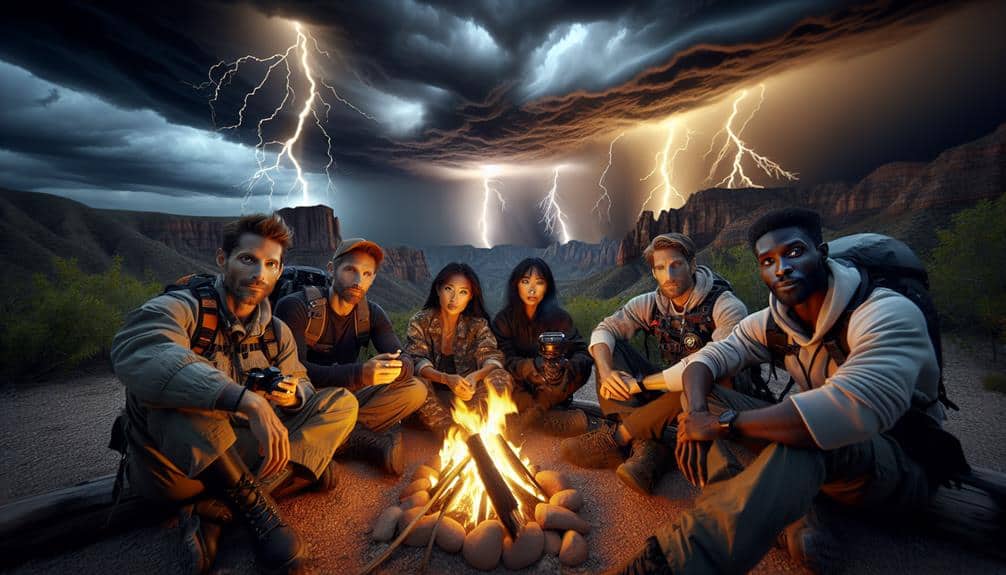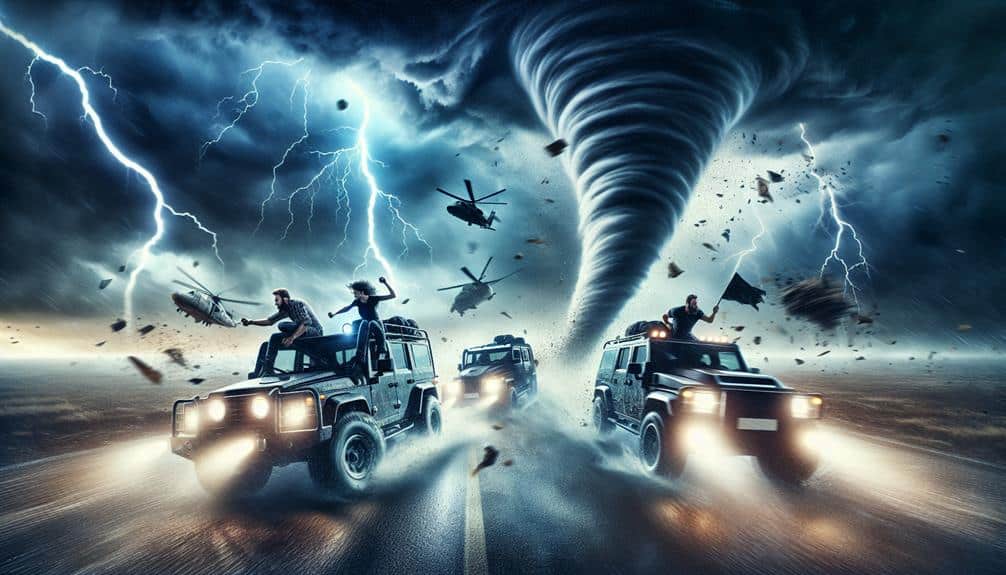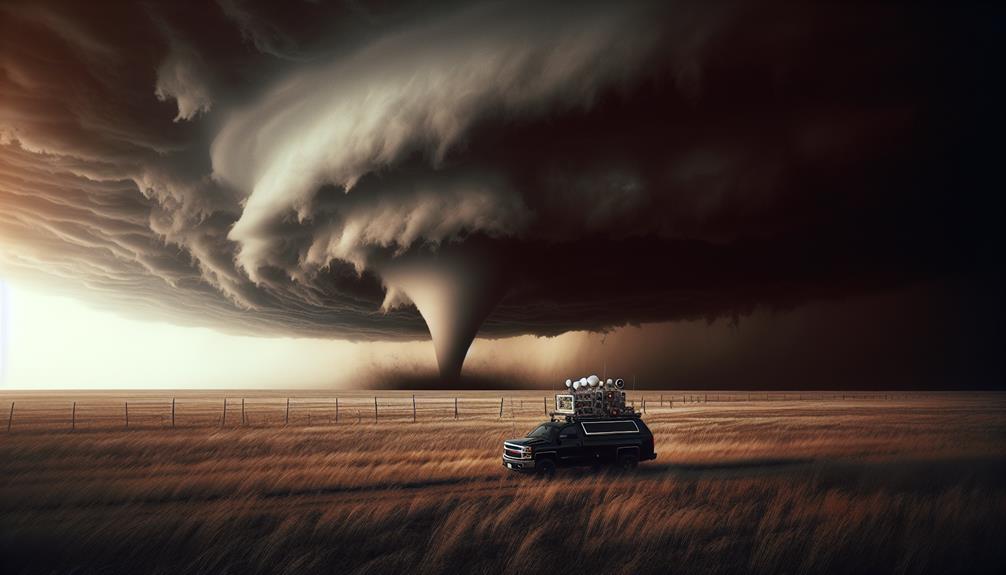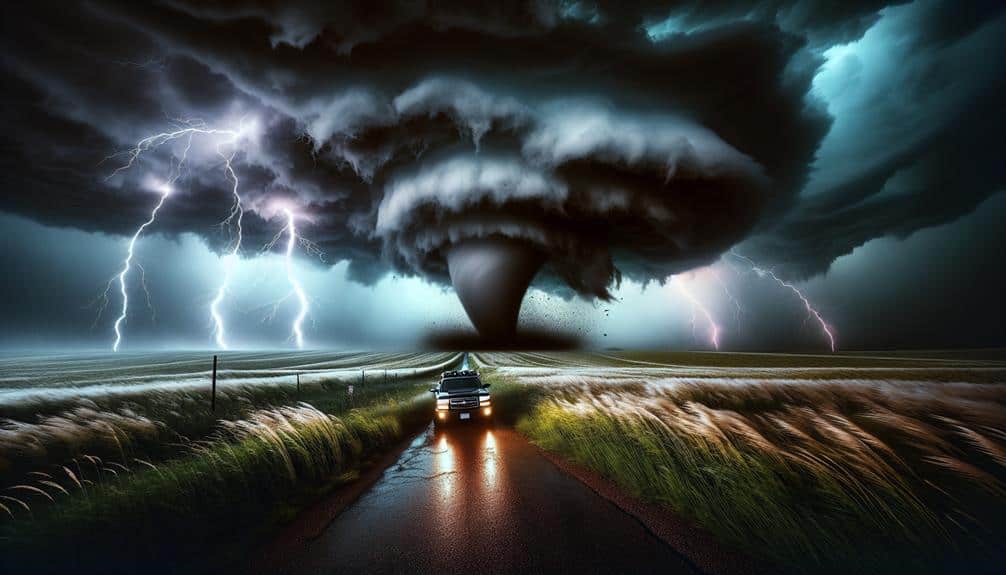Storm chasing affects our mental health due to the intense adrenaline rush and the emotional toll of such a high-stress activity. The unpredictable weather conditions elevate anxiety, and the fear of equipment failure or safety concerns adds significant stress. Over time, this constant exposure to danger can diminish emotional resilience and even lead to PTSD-like symptoms. Effective coping mechanisms like therapy, mindfulness, and community support are vital to maintaining mental health. By understanding these impacts, we can better manage the challenges storm chasing presents and learn how to support ourselves and each other.
Key Points
- Constant exposure to unpredictable and life-threatening conditions induces chronic anxiety and stress.
- The adrenaline rush from storm chasing can result in emotional toll and psychological trauma.
- Frequent high-stress environments can lead to PTSD-like symptoms and diminished emotional resilience.
- Extended periods away from home may cause social isolation and impact mental health.
Psychological Thrill and Trauma
Many of us are drawn to storm chasing for the adrenaline rush, but we must also consider the potential for psychological trauma. The thrill of pursuing a tornado or capturing a lightning storm can be intoxicating. The adrenaline rush we experience is a powerful motivator, pushing us to confront nature's most extreme conditions. However, this high-octane pursuit has an emotional toll that can't be overlooked.
Storm chasing inherently involves a significant fear factor. Facing nature's fury head-on requires psychological resilience. We need to be prepared not just physically, but also mentally, to handle the intense situations we find ourselves in.
Research has shown that exposure to such high-stress environments can lead to symptoms similar to post-traumatic stress disorder (PTSD). The emotional toll can manifest in anxiety, nightmares, and even depression.
While the freedom to chase storms is exhilarating, we must acknowledge that the psychological impacts are real and potentially long-lasting. Balancing the thrill of the chase with mental well-being is essential. By being aware of the risks, we can take steps to build our psychological resilience and mitigate the emotional toll that comes with storm chasing.
Stress of Unpredictable Conditions
Storm chasing often exposes us to unpredictable conditions that can elevate stress levels and strain our mental fortitude. The very nature of tracking storms means we're constantly dealing with rapidly changing weather patterns. This unpredictability can induce significant anxiety. Our minds are in a perpetual state of alertness, ready to respond to the next sudden shift in conditions.
Fear is a companion on these pursuits, not just because of the storms themselves but also due to the potential for unforeseen dangers. We're exploring unfamiliar terrains, often in low-visibility and high-risk situations. The fear of equipment failure or getting caught in a storm's path adds another layer of stress.
Evidence suggests that this continual exposure to high-stress scenarios can lead to increased levels of cortisol, the stress hormone. In the short term, this might keep us sharp and focused, but over time, it can contribute to chronic anxiety and health issues.
We chase storms for the thrill and the freedom it provides, but we must acknowledge the mental toll it takes. Understanding these stressors can help us manage them better and maintain our mental health while pursuing our passion.
Long-Term Emotional Impact
How do the prolonged experiences of storm chasing shape our emotional well-being over time?
We often find ourselves maneuvering through a complex emotional landscape. Initially, the adrenaline and sense of adventure may fuel our passion, but over time, the constant exposure to high-stress situations can take a toll on our mental health. Studies show that repeated encounters with life-threatening conditions can diminish our emotional resilience, making it harder to bounce back from stress.
We've also noticed that the constant uncertainty can lead to chronic anxiety and even post-traumatic stress disorder (PTSD). According to research, these conditions aren't uncommon among storm chasers, who often witness devastating scenes and experience close calls. The emotional impact accumulates, leading to feelings of helplessness and fear.
However, our ability to develop coping strategies plays a vital role in mitigating these effects. Those of us who employ effective coping mechanisms—such as mindfulness, peer support, and structured downtime—tend to maintain better emotional health.
Coping Mechanisms and Support
Recognizing the emotional challenges we face, it's essential that we explore effective coping mechanisms and support systems to sustain our mental health.
The thrill and unpredictability of storm chasing can leave us feeling emotionally drained and anxious. Therapy sessions are a valuable resource that offer a structured space to process these intense experiences. Cognitive-behavioral therapy (CBT), for example, helps us reframe negative thought patterns and develop healthier responses to stress.
Support groups also play an important role. Engaging with others who understand the unique pressures of storm chasing can provide a sense of community and validation. These groups allow us to share our experiences and coping strategies, creating a collective resilience. Evidence shows that peer support can significantly reduce feelings of isolation and improve overall well-being.
It's crucial that we prioritize self-care practices such as mindfulness and regular physical activity. These can mitigate the stress associated with our high-adrenaline pursuits. Additionally, maintaining open communication with loved ones helps to create a supportive environment, reinforcing our mental resilience.
Community and Social Dynamics

Our storm chasing community thrives on the strong social dynamics that foster collaboration, trust, and mutual support. We depend on each other not just for safety but for emotional and psychological well-being. When we face the unpredictable and often dangerous elements, it's this community support that keeps us grounded.
However, it's equally essential to recognize how storm chasing can sometimes lead to social isolation. The nature of our pursuit often requires us to be away from home for extended periods, disrupting our usual social circles. This, in turn, can lead to feelings of loneliness and detachment.
Here are some key factors that influence our community and social dynamics:
- Shared Experiences: Bonding over intense, life-altering experiences strengthens our connections.
- Communication Networks: Regular updates and check-ins via social media and group chats keep us connected.
- Support Systems: Emotional and psychological support from fellow chasers is invaluable.
- Mentorship: Experienced chasers guiding newcomers fosters a sense of belonging and purpose.
Understanding these dynamics can help us mitigate the negative impacts of social isolation, ensuring that our community remains a source of strength and resilience.
Frequently Asked Questions
How Does Storm Chasing Impact Family Relationships and Home Life?
Storm chasing impacts family relationships and home life by causing emotional strain and communication breakdown. The time commitment disrupts family dynamics, leading to feelings of neglect and stress. We need balance and understanding to maintain harmony.
Are There Any Physical Health Risks Associated With Storm Chasing?
When we chase storms, physical health risks and safety concerns come into play. High winds, debris, and lightning threaten our safety. We must stay informed and prepared to minimize these dangers while pursuing our passion for freedom.
What Financial Costs Are Involved in Storm Chasing?
Balancing the thrill of storm chasing with financial burden, we face high equipment costs and travel expenses. Insurance coverage is essential, but it adds another layer. Despite the freedom we seek, these costs can be significant.
How Does Storm Chasing Affect One's Professional Life and Career Stability?
Storm chasing can impact career advancement and job satisfaction. While it offers excitement and freedom, the unpredictability can hinder stability. Balancing our passion with professional responsibilities requires careful planning to avoid jeopardizing career growth and fulfillment.
Is There a Specific Training or Certification Required for Storm Chasing?
Picture a compass guiding us through chaos. We need specialized training and certification for storm chasing, emphasizing safety precautions and weather knowledge. Ensuring we're prepared frees us to explore nature's fury with confidence and responsibility.


